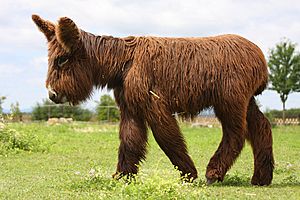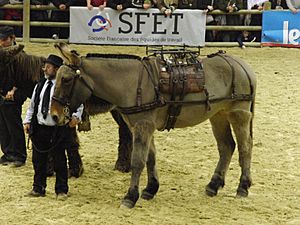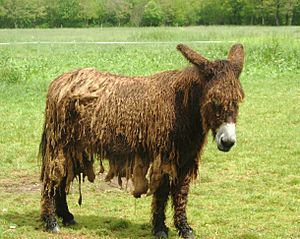Baudet du Poitou facts for kids

Year-old jenny foal
|
|
| Conservation status | FAO (2007): endangered |
|---|---|
| Other names |
|
| Country of origin | France |
| Distribution | world-wide |
| Standard | Haras Nationaux (in French) |
| Use | siring mules |
| Traits | |
| Height |
|
| Coat | dark bay |
|
|
The Baudet du Poitou, also known as the Poitevin or Poitou donkey, is a special breed of donkey from France. It's one of the biggest donkey breeds. Male Poitou donkeys (called 'jacks') were often bred with Poitevin horse mares to create strong Poitevin mules. These mules were once very popular around the world for farm work and other jobs. The Baudet has a unique coat that hangs in long, shaggy locks, sometimes called cadenettes.
This breed developed in the Poitou region of France. Donkeys might have been brought there by the Roman Empire. Poitou donkeys may have been a sign of importance during the Middle Ages. By the early 1700s, their special looks were already well-known. A studbook (a record of purebred animals) for the breed was started in France in 1884. In the 1800s and early 1900s, these donkeys were used to make mules all over Europe. Poitou donkeys also helped create other breeds, like the American Mammoth Jack in the United States.
However, as machines became more common in the mid-1900s, fewer mules were needed. This caused the number of Poitou donkeys to drop a lot. By 1977, only 44 of them were left worldwide. Luckily, many groups and people started working to save the breed. By 2005, there were 450 purebred Poitou donkeys.
Contents
History of the Poitou Donkey
We don't know the exact start of the Poitou donkey breed. However, donkeys and mule breeding might have been brought to the Poitou area of France by the Roman Empire. The Baudet de Poitou donkey and the Mulassière horse breed (also called the Poitevin horse) were developed together. Their goal was to create excellent mules.
In the Middle Ages, owning a Poitou donkey might have been a status symbol for important families in France. We don't know exactly when the Poitou donkey got its special features. But by 1717, they seemed very well-known. An advisor to King Louis XV described them: "There are donkeys in northern Poitou that are as tall as large mules. They are almost completely covered in hair a half-foot long, with legs and joints as big as a carriage horse's."
In the mid-1800s, Poitevin mules were thought to be "the best and strongest in France." Between 15,000 and 18,000 of them were sold each year. In 1884, a studbook was created for the Poitou donkey in France. During the early 1900s, the mules bred from Poitou donkeys and Poitevin horses were still wanted across Europe. They were called the "finest working mule in the world." People paid more for Poitevin mules than for others. Up to 30,000 were bred each year in Poitou, and some thought the number was as high as 50,000.
After World War II, machines became more common. Mules were no longer needed as much, and the numbers of both mules and donkeys fell sharply.
Some old breeding methods used by Poitou donkey and mule breeders were unusual. For example, male donkeys were kept in small stalls all year. Also, some people believed that if female donkeys were underfed during pregnancy, they would have male foals, which were more valuable. This sometimes led to mares being starved. Newborn foals were sometimes not given Colostrum, which is very important for their health. A lack of good breeding records also caused problems with fertility. Many foals died because male donkeys were used to breed with horses before their own kind. This meant Poitou foals were born late in the year, making them weak in cold weather.
Despite these issues, one writer in 1883 said that "mule-breeding is about the only part of farming where France has no rivals, thanks to the hard work of those involved."
Saving the Poitou Donkey
A count of the breed in 1977 found only 44 Poitou donkeys worldwide. By 1980, there were still fewer than 80 animals. Many public and private groups in France started working to save them. In 1979, the Haras Nationaux (the French national stud) and the Parc Naturel Regional du Marais Poitevin, along with private breeders, began efforts to improve the Poitou's genetics. They also worked on new breeding methods and collecting old knowledge about the breed.
In 1981, 18 large donkeys from Portugal were brought in to help breed Poitou donkeys. This led to the creation of the Asinerie Nationale Experimentale. This experimental breeding farm opened in Dampierre-sur-Boutonne in Charente-Maritime in 1982. The Parc also works to save the Poitevin horse breed. In 1988, a group called the Association pour la Sauvegarde du Baudet du Poitou (SABAUD) was formed. It helps with marketing and raising money for the breed. The Association des Éleveurs des Races Équine, Mulassière et Asine, Baudet du Poitou is the official group that registers Poitou donkeys.
Early efforts to save the breed sometimes faced problems. Some breeders sold mixed-breed Poitous as purebreds, which were worth much more money. Fake papers were sometimes used for these sales. However, by the 1990s, DNA testing and microchips began to be used to identify and track purebred animals.
The efforts to save the breed in the late 1900s and early 2000s were successful. A survey in 2005 found 450 purebred registered animals. This number dropped slightly to just under 400 by 2011. The French studbook for the breed has two parts. Livre A is for purebred animals with Poitou parents on both sides. Livre B is for animals with one purebred Poitou parent. The American Livestock Breeds Conservancy lists the Poitou as "Critical." This means there are fewer than 2,000 animals worldwide and fewer than 200 new registrations each year in the US.
In 2001, scientists in Australia successfully put a Poitou donkey embryo (a very early stage of a baby animal) into the womb of a Standardbred mare. This was done because there were worries that the biological mother might have joint problems during pregnancy. The foal born from this became one of three Poitou donkeys in Australia. This procedure was special because it's often hard for one type of Equus animal (like a horse) to accept an embryo from another type (like a donkey).
Poitou Donkeys in the United States
Records show that Poitou donkeys were brought from France to the US several times in the 1800s and early 1900s. For example, 10 donkeys were imported in 1910. Most of these were mixed with other donkeys rather than being kept pure. During this time, Poitous were used to help create the American Mammoth Jack breed. Because they were expensive to buy and transport, the Poitou breed played a smaller role in the Mammoth Jack's development than some breeders wanted. Imports to the US continued until at least 1937, when a successful breeding male donkey named Kaki, who was 16.2 hands (66 inches, 168 cm) high, was brought to the country.
From the 1940s to the 1960s, very few Poitou donkeys were imported. Only a few more arrived between 1978 and the 1990s. By 1996, there were only about 30 Poitou donkeys in North America.
In 1996, an American named Debbie Hamilton started the Hamilton Rare Breeds Foundation in Hartland, Vermont. Her goal was to breed Poitou donkeys. By 2004, she owned 26 purebred and 14 part-bred Poitous. This made her farm the largest Poitou breeding place in the United States, and the second largest in the world, after the French government's experimental farm. Hamilton works with French officials to help save the breed. French veterinarians have praised her help.
Scientists in France have been working since at least 1997 on ways to freeze and store male donkey cells (sperm bank) for Poitou donkeys. Hamilton has been a leader in using artificial insemination with frozen cells. This allows her to use genetic material from France to improve Poitou herds in the US. The North American Baudet de Poitou Society, which is part of the American Donkey and Mule Society, is the official US registry for the breed. They work with French officials to check and register Poitou donkeys bred in America.
Characteristics of the Poitou Donkey
The Baudet is a large breed of donkey. Among other European donkeys, only the Andalucian donkey is similar in size. To breed large mules, the first Poitou breeders chose donkeys with big features, like large ears, heads, and leg joints. Their ears grew so big that their weight sometimes made them hang sideways.
Male Poitou donkeys should be at least 1.40 m (55 in) tall, and females should be at least 1.35 m (53 in) tall. They have large, long heads, strong necks, long backs, short rumps, and round hindquarters. Their leg joints and feet are large, and their legs are strong. Their personality is described as "friendly, loving, and gentle."
In Poitou, the Baudet's coat was traditionally left ungroomed on purpose. Over time, it formed cadenettes, which are long, shaggy locks, a bit like dreadlocks. These sometimes grew so long they touched the ground! A Baudet with such a long coat was called bourailloux or guenilloux. This shaggy coat is such a strong dominant trait that even a donkey with only 1/8 Poitou blood might have it.
The coat is usually dark bay, which means it can be dark brown to black. It can also be fougère, where the silver-grey around the mouth and eyes has a reddish edge. The belly and the insides of the thighs are pale. They should not have "white ticking" (small white hairs) or a dark line down their back (called a dorsal mule-stripe).
Uses of the Poitou Donkey
The Baudet was traditionally used only for breeding mules. The word baudet actually means "donkey father," but it's used to describe the whole breed. Now that fewer mules are bred, some Poitou donkeys are used for farm work, for pulling carts, or for riding.
See also
 In Spanish: Baudet du Poitou para niños
In Spanish: Baudet du Poitou para niños




